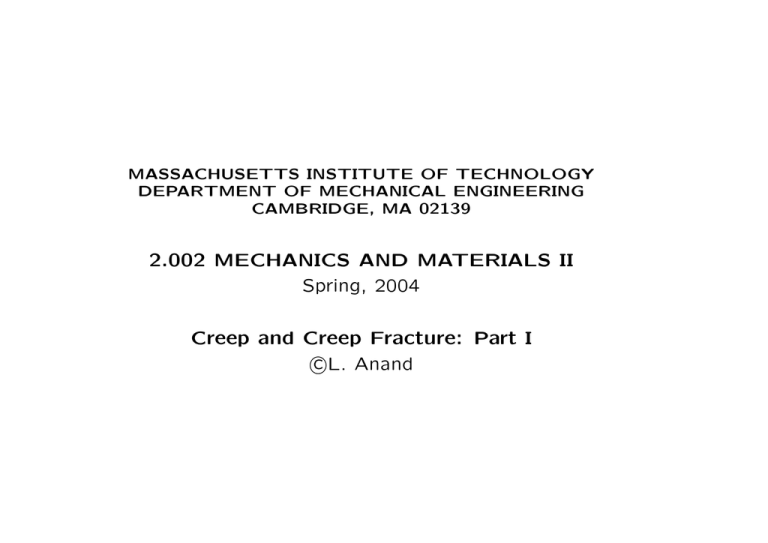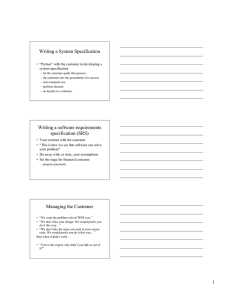Document 13664837
advertisement

MASSACHUSETTS INSTITUTE OF TECHNOLOGY DEPARTMENT OF MECHANICAL ENGINEERING CAMBRIDGE, MA 02139 2.002 MECHANICS AND MATERIALS II Spring, 2004 Creep and Creep Fracture: Part I c L. Anand � RATE-DEPENDENCE AND RATE-INDEPENDENCE OF PLASTIC RESPONSE • Plastic deformation in metals is thermally-activated and inherently rate-dependent. • However, the plastic stress-strain response of most single and polycrystalline materials at absolute temperatures T < 0.35 Tm, where Tm is the melting temperature of the material in degrees absolute, is only slightly rate-sensitive, and in this temperature regime it is often be modeled as rate-independent. We shall first consider a rate-independent theory. Material Melting Temp, C Tm, K 0.35 Tm, K ≡ C Ti Fe Cu Al Pb 1668 1536 1083 660 327 1941 1809 1356 933 660 679 633 452 327 231 406 360 201 54 -42 Consequences of Viscoplastic Deformation at High Homologous Temperature For isothermal deformation (T=const) Creep Test • A typical creep test consists of instantaneously loading a cylindrical test specimen of a material to a constant stress, which is maintained at a constant temperature. The resulting strain is measured as a function of time. Idealization of Creep Curve • For deformation analysis at constant temperature, the strain-time response may be idealized as � = �e + �˙ csst �˙ = �˙ e + �˙ css σ̇ e �˙ = E Stress Dependence of �˙ css at Constant Temperature �˙ css = �˙ 0 � �n σ s Temperature-Dependence of �˙ css at Constant σ Preliminaries • Avogadro’s number: NA = 6.022×1023 atoms/molecules per mole • Boltzmann’s constant k = 1.381 × 10−23 J/K • Universal gas constant R = NAk = 8.314 J(mol)−1K −1 • Mole: 1 mole of any substance is that mass of the substance containing NA atoms/molecules; e.g., the mass of 1 mole of C 12 atoms is 12 grams. Temperature Dependence of �˙ css at Constant Stress • The slope of the curve is m/1 = −Q/R, where Q is called the activation energy for creep, with units J(mol)−1. Then for a constant C(σ), the above curve can be mathematically represented as Q ln�˙ css = lnC − R � �� 1 T � Q ⇐⇒ �˙ css = Cexp − RT � � An Important Observation • Let us evaluate the increase in �˙ css for a material with Q = 270 kJ/mol when the temperature is increased from T1 = 8000 C = 1073 K to T2 = 8200 C = 1093 K. �˙ css1 = exp c �˙ ss2 � � Q 1 1 − R T2 T1 �� = 0.5746 • Therefore, with a temperature increase of only 200C, the creep rate almost doubled!! • Caution: the temperature T must be expressed in kelvins Combined Stress and Temperature Dependence of �˙ css Q �˙ c = Aexp − RT � A Q n s � � Q �˙ 0 = Aexp − RT � �� � �n σ s pre-exponential factor (s−1) creep activation energy (J/mol) creep exponent reference stress which produces a strain rate �˙ 0 Summary of One-Dimensional Creep Equation �˙ = �˙ e + �˙ c σ̇ ; E = E(T ) �˙ e = E � � �� � �n Q σ c �˙ = Aexp − RT s (1) (2) (3) • Note that equation (3) states that the rate of creep (or ‘viscoplastic’) strain increases exponentially with temperature, so that the time required for a given amount of creep strain decreases exponentially with temperature. Example Problem: Stress Relaxation • Consider a bolt with pre-tension σ = σi at time t = 0. Given that the bolt is maintained at constant temperature, determine the pre-tension at some time t. The isothermal constitutive equation for steady state creep is given by �˙ c = Bσ n with n �= 1 Example Problem: Stress Relaxation (cont.) �˙ = �˙ e + �˙ c ⇒ 0 = �˙ e + �˙ c since � = const in the bolt σ̇ 1 dσ n ⇒0 = + Bσ ⇒ = −Bσ n E E dt ⇒ σ −ndσ = −EB dt ⇒ −(n−1) ⇒ σ(t)−(n−1) − σi � σ(t) σi =σ(0) σ −ndσ = −EB = (n − 1)EBt ⇒ σ(t) = σi [1 + (n − 1) t Bσin (E/σi)]1/(n−1) • Defining the characteristic relaxation time tr such that σ(tr ) = σi/2, we get � t 0 dt 2(n−1) − 1 2(n−1) − 1 tr = = c /(σ /E) (n−1) (n − 1)˙ � i (n − 1)EBσi i







